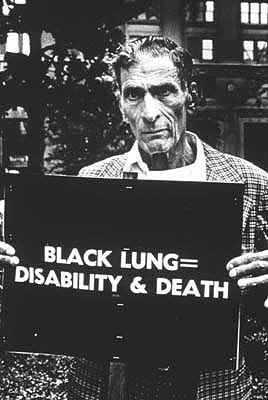As black lung rises among Appalachian coal miners, industry and regulators block action

After years of decline, the number of U.S. coal miners suffering from dreaded black lung disease appears to be rising again -- and the increase seems to be especially dramatic in southern Appalachia, the Times West Virginian reports:
About 36 percent of miners who participated in [National Institute for Occupational Safety and Health] studies and had worked in the mines for 25 or more years in a mine had black lung in 1970, according to figures compiled by Dr. Edward Petsonk of NIOSH. That number declined until it reached 7 percent in 1995.
Since then, the number of cases has started to creep back up. The most recent data indicates that 13 percent of miners who had 25 or more years of experience had the disease.
The rise in black lung cases appears to be concentrated in mines in eastern Kentucky, western Virginia and southern West Virginia.
The disabling and potentially fatal condition, which is caused by inhaling coal dust, also appears to be affecting miners at a younger age, according to NIOSH's Enhanced Coal Workers' Health Surveillance Program. Once most common among people who had worked in the mines for a quarter-century or more, black lung is now appearing in those who've worked in the mines for less than 25 years.
Petsonk told the paper that one possible reason the disease is on the increase is that miners are drilling into more rock to extract coal. That can stir up silica dust, which is even more toxic to the lungs than coal dust. But Petsonk said he can't be sure because mine owners are denying NIOSH researchers the access they need to study the problem.
For example, NIOSH wants to monitor dust levels at various operations in the mines. The National Mining Association, an industry group, argues that dust levels are already monitored according to federal regulations. However, those regulations do not mandate monitoring over time, and dust levels can vary considerably from one day to the next.
The Federal Coal Mine Health and Safety Act requires that coal dust levels in underground mines not exceed 2 milligrams per cubic meter of air. The Mine Safety and Health Administration was preparing to heed the advice of NIOSH and a congressional committee by lowering the acceptable limit, but it dropped those plans after President Bush took office.
That sparked a lawsuit from the Appalachian Center for the Economy and the Environment and the Appalachian Citizens' Law Center, who want the current standard cut in half. Filed on behalf of a coal miner in Eastern Kentucky, the suit is currently before the Sixth Circuit Court, where a judge is considering MSHA's request for dismissal.
(Photo of 1960s black lung protester from United Mine Workers of America)
Tags
Sue Sturgis
Sue is the former editorial director of Facing South and the Institute for Southern Studies.
